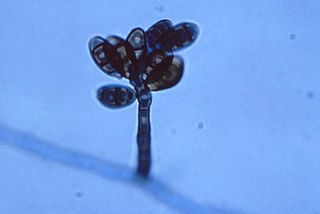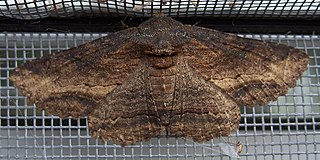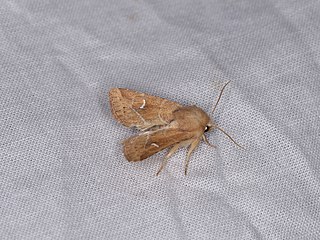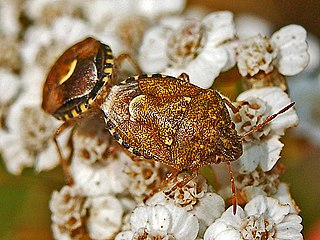
Eupithecia is a large genus of moths of the family Geometridae. There are hundreds of described species, found in all parts of the world, and new species are discovered on a regular basis.

The lime-speck pug is a moth of the family Geometridae. It is a common species throughout the Palearctic region, the Near East and North Africa.

The common pug(Eupithecia vulgata) is a moth of the family Geometridae. It is a common species across the Palearctic region, the Near East and North Africa. It ranges from the Atlantic coast of Ireland and Portugal across Europe, the Middle East and Central Asia to the Russian Far East (Priamurje) and Korea.

The grey pug is a moth of the family Geometridae. It is found throughout the Palearctic region and the Near East. It is also found in North America.

The juniper pug or juniper looper is a moth of the family Geometridae. The species was first described by Michael Denis and Ignaz Schiffermüller in 1775. It is found throughout the Palearctic and Nearctic regions and the Near East.

Curvularia is a hyphomycete (mold) fungus which is a facultative pathogen, or beneficial partner of many plant species and common in soil. Most Curvularia are found in tropical regions, though a few are found in temperate zones.

Nail-tail wallaby refers to Onychogalea, a genus describing three species of macropods, all of which are found in Australia. Related to kangaroos and wallabies, they are smaller sized species distinguished by a horny spur at the end of their tail. The northern nail-tail wallaby is still common in the northern part of Australia, the crescent nail-tail is now extinct, and the bridled nail-tail is considered rare and endangered, with probably fewer than 1100 mature individuals in the wild. Nail-tail wallabies are smaller than many other wallabies.

Zale lunata, the lunate zale, is a moth of the family Noctuidae. The species was first described by Dru Drury in 1773. It is found throughout the east and west of North America. The wingspan is 40–55 mm. The moth flies from March to September depending on the location. The larvae feed on various deciduous trees, such as maple, willow and Prunus.

Eupithecia venosata, the netted pug, is a moth of the family Geometridae. It was first described by Johan Christian Fabricius in 1787. It is found across the Palearctic ecozone from Portugal and Morocco in the west to the Lake Baikal in Siberia and Afghanistan and Pakistan in the east.

Eupithecia satyrata, the satyr pug, is a species of moth of the family Geometridae. It was described by Jacob Hübner in 1813. It is found from Ireland, through northern and central Europe east to all of Russia and central Asia and western Siberia to Tibet. It is also present in North Africa and North America.
Astyris lunata is a species of sea snail, a marine gastropod mollusk in the family Columbellidae, the dove snails.

Hypotrix lunata is a moth of the family Noctuidae. It is found from south-eastern Arizona southward to the State of Durango in northern Mexico.

Lymantria lunata is a species of moth of the family Erebidae. It is found in Southeast Asia, from India to the northeast coast of Australia.
Euproctis lunata, the castor hairy caterpillar, is a moth of the family Erebidae. The species was first described by Francis Walker in 1855. It is found in India, Pakistan, Sri Lanka and Thailand.
Heterocampa lunata is a species of moth in the family Notodontidae. It was first described by Henry Edwards in 1884 and it is found in North America.

Amphipoea lunata is a species of cutworm or dart moth in the family Noctuidae. It is found in North America.
Mozena lunata is a species of leaf-footed bug in the family Coreidae. It is found in Central America and North America.
Notonecta lunata is a species of backswimmer in the family Notonectidae. It is found in North America.

Staria lunata is a species of shield bug belonging to the family Pentatomidae. It is the only species of the genus













